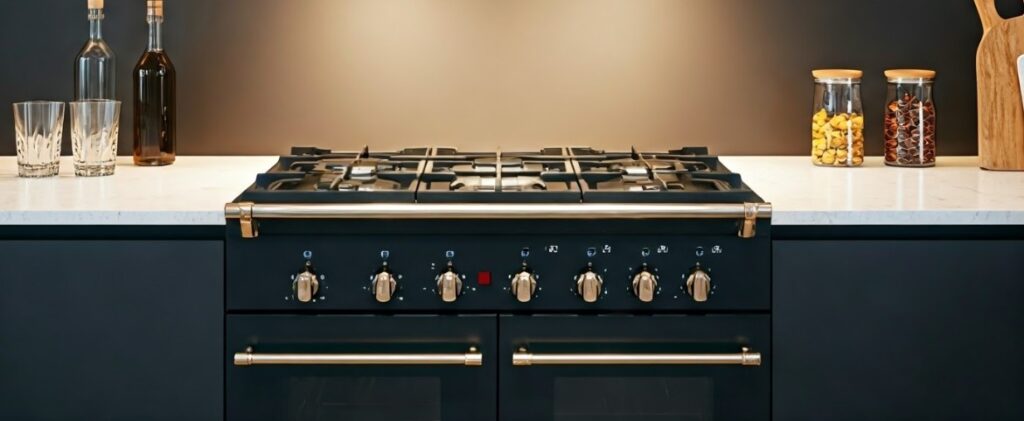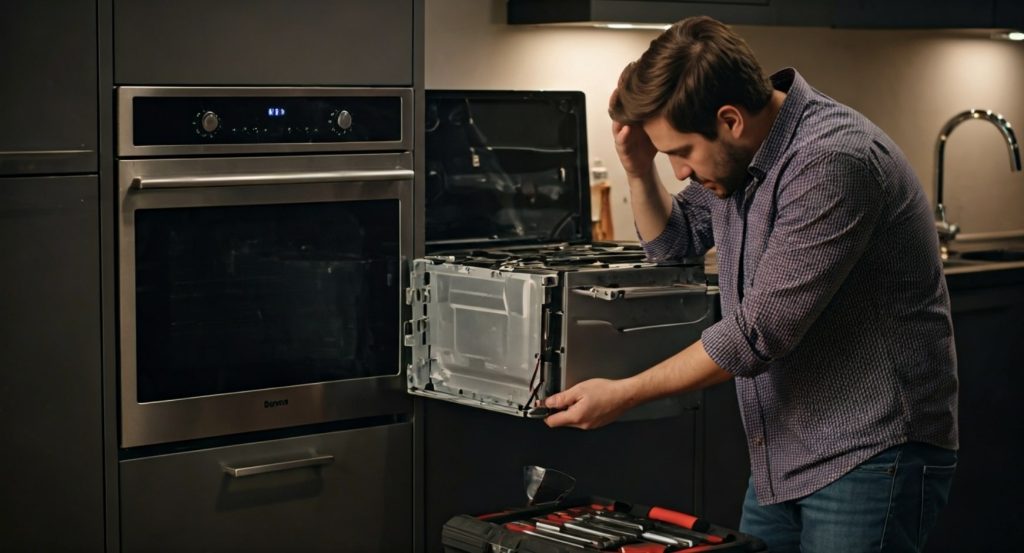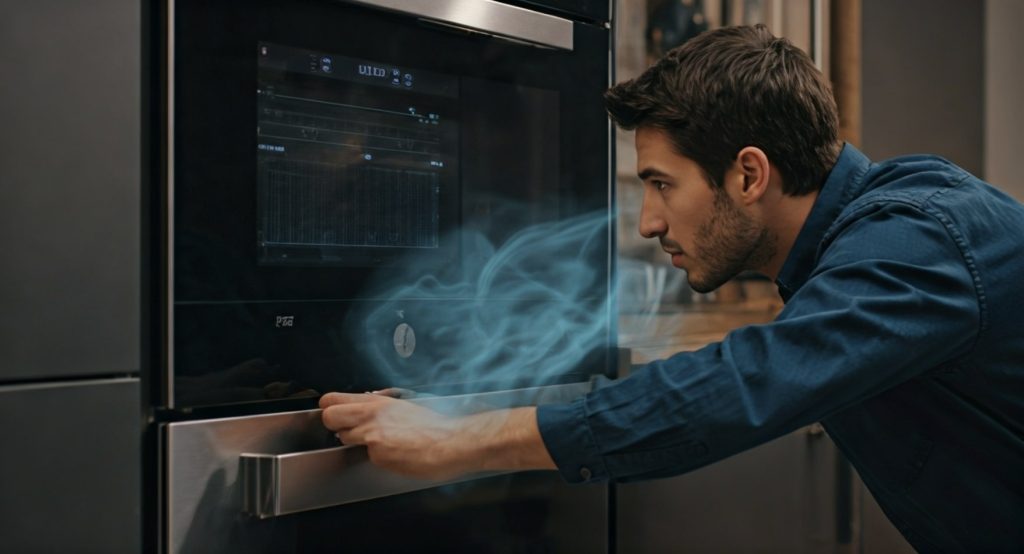The clicking sound from your Viking stove or other brand can be confusing, even after the burner lights. It’s important to understand that the clicking sound is a normal part of the ignition process for gas stoves. However, if the clicking continues after the burner has lit, it could indicate a problem. Let’s dive into some possible reasons behind your stove keeps clicking after ignition and how to troubleshoot it.
Understanding Your Stove’s Ignition System
Your gas stove’s ignition system is like the brain that makes those pretty blue flames for your cooking. Instead of using a pilot light that stays on all the time, modern gas stoves use an electric ignition system to make a spark that lights the gas.
When you turn the burner knob, the ignition system sends electricity to the igniter through the spark ignition switch. This igniter is a small ceramic part near each burner. The electrical current warms up the igniter, which then creates a spark. At the same time, the gas valve opens. This lets gas flow to the burner. The gas meets the spark and catches fire, creating the flame.
Common Signs of Ignition Issues
Aside from the clear clicking sound, there are other signs that show your stove might have a problem with its ignition system. Knowing these signs can help you fix the issue quickly.
One common sign is if the clicking continues even after the burner lights up. In a stove that works well, the clicking should stop when the flame is present.
You may also notice a weak or uneven flame, a delay in lighting, or a gas smell even when the burner is off. These are warning signs that indicate your stove’s ignition system needs care.
Preparing for Troubleshooting
Before you start fixing that annoying clicking, it is very important to prioritize safety and get the right tools. Remember, you are working with gas appliances, so safety must come first.
Ensure your workspace has good airflow and is free from anything that can catch fire. Also, make sure to turn off the gas supply to your stove at the source before you begin troubleshooting.
Safety First: What You Need to Know
Working with gas appliances requires careful attention. Before you start repairing or troubleshooting, keep in mind these important safety tips:
- Gas Leaks: Don’t try to fix or find a gas leak by yourself. If you smell gas, quickly turn off the gas supply at the main valve. Leave the area and call your gas company or the fire department.
- Ventilation: Make sure your working area has plenty of air. Open windows and doors to let fresh air in and stop gas from building up.
- Professional Help: If you are unsure about any part of the process or feel uneasy working with gas appliances, reach out to a qualified technician for help.
Tools and Resources You Will Need
To fix your stove easily, it’s good to have these tools and items ready:
- Soft-bristled brush or toothbrush: For cleaning the burner and igniter.
- Paperclip or metal pin: To remove debris from the burner ports.
- Dry cloth or paper towels: For drying and cleaning.
- Fan (optional): To speed up drying off moisture.
Having these items close by will help you troubleshoot better and faster.
Step-by-Step Guide to Fixing the Clicking Issue
Now that you are ready, let’s look at the troubleshooting steps. These steps will help you figure out the common reasons for a clicking gas stove.
Keep in mind, if any steps involve the gas line or if you feel unsure about doing them, it is safer to call a qualified technician.
Step 1: Clean the Burner and Igniter
Grease, food bits, and dirt can build up on the burner and igniter. This can cause problems with the spark and gas flow. Cleaning these parts is a great first step to fix the clicking noise.
First, make sure the burner is cool. Take off the burner grate and the burner cap. Use a soft brush or an old toothbrush to clean the burner head. Be careful to clean the small holes where the gas flows.
Also, clean the igniter by removing any dirt that might block the spark. After cleaning, put the burner back together and check if the clicking sound continues.
Step 2: Check and Adjust the Burner Cap
The burner cap is important because it helps direct the gas flow and keep a steady flame. If it’s not aligned right or sitting correctly, the gas flow can be interrupted. This may cause ignition issues and clicking sounds.
Check the burner cap for any damage or bending. Make sure it lines up with the burner head and lies flat on the base. If it’s not aligned properly, adjust it carefully until it fits securely.
After placing the burner cap correctly, try to light the burner again to check if the clicking has stopped.
Step 3: Dry Out Moisture
Moisture can seriously damage your stove’s ignition system. This can stop the spark from lighting the gas. It is more common with electric stoves, where spills can harm electrical parts.
If you think moisture is the problem, make sure the burner is off and cold. Use a dry cloth or paper towels to dry the burner head, igniter, and the area around it.
You can also aim a fan at the burner or cover it with a towel to soak up extra moisture. Let the burner dry completely before trying to light it again.
Contact Viking Repair Pro for Reliable Service
If you’ve diligently followed the troubleshooting steps but your stove keeps clicking, it’s time to call in the experts at Viking Repair Pro. We specialize in providing reliable and efficient repair services for all your appliance needs. Our team of skilled technicians has the experience and expertise to quickly diagnose and resolve any issues with your stove, ensuring its safe and optimal operation. Trust Viking Repair Pro for all your appliance repair needs.
Conclusion
Keeping your stove in top condition starts with understanding how its ignition system works. If your Viking stove keeps clicking after ignition, it’s often a sign of a simple issue—something you can often troubleshoot with our straightforward repair guide. From misaligned burner caps to moisture buildup or faulty igniters, these are all problems that can be solved with the right knowledge and care.
However, always prioritize safety when dealing with any appliance issue. Routine cleaning and regular maintenance are key to preventing ignition-related problems in the first place. By taking proactive steps, you not only extend the life of your stove but also ensure a safer cooking environment.
If the issue persists or you prefer expert hands-on assistance, don’t hesitate to reach out to Viking Repair Pro. Our certified technicians are trained to diagnose and fix all types of Viking appliance issues efficiently.
Need help with other Viking appliances too? We proudly serve a wide range of areas and offer specialized services, including:
-
West Lake Hills Viking Oven Repair: For precise and reliable oven repairs, we’ve got West Lake Hills covered.
-
Bryn Athyn Viking Oven Repair: Restore your Viking oven’s performance with our trusted experts in Bryn Athyn.
-
Reston Refrigerator Repair: Fast and efficient repairs for Viking refrigerators in Reston.
-
Lancaster Viking Dishwasher Repair: Keep your dishes spotless with professional dishwasher repair services in Lancaster.
-
Norristown Viking Dishwasher Repair: Trust us for thorough Viking dishwasher diagnostics and repairs in Norristown.
-
Denver Viking Freezer Repair: Don’t let a faulty freezer ruin your food—call our Denver team today.
-
Carson Freestanding Range Repair: Dependable range repair services available now in Carson.
-
Bloomfield Range Repair: High-quality range repairs tailored to Viking appliances in Bloomfield.
-
Crowells Corner Range Repair: Ensure smooth kitchen operations with expert range repair in Crowells Corner.
-
Rolling Hills Viking Oven Repair: We bring fast and effective Viking oven solutions right to Rolling Hills homes.
Looking for more appliance tips? Explore our FAQ section for quick answers, or browse our comprehensive blog library for expert advice on appliance maintenance and troubleshooting.
👉 Don’t wait for a small issue to become a big one—schedule your Viking appliance repair with Viking Repair Pro today and cook with confidence!
Frequently Asked Questions
Is it safe to use the stove if it keeps clicking?
A gas stove that makes a clicking sound isn’t always a direct risk, but it’s smart to be careful. If you smell gas while it clicks, turn off the gas supply right away. Then, call a qualified technician for help.
How often should I clean my stove to prevent clicking?
Cleaning your stove regularly is very important. It helps stop clicking sounds and makes your stove last longer. Try to clean the stovetop, burners, and igniters at least once a week. If you cook a lot, you should clean them even more often.
Can moisture affect my stove’s ignition system?
Yes, moisture can really impact your stove’s ignition system. Too much moisture can disrupt the spark. This makes it hard for the gas to ignite correctly. Be sure to keep your stovetop dry and clean up any spills quickly.









